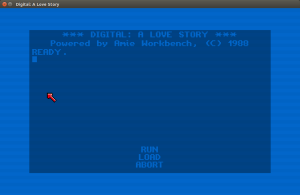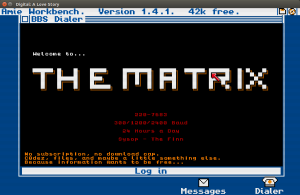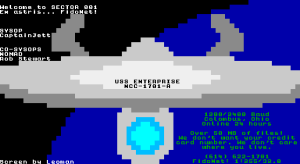
When you start “Digital: a love story” you are greeted with this welcome screen for the “Amie Workbench” which was inspired be the original Amiga GUI.
“Digital: a love story” is one of those pieces of media that was a long time in coming; it now has a whole personal story wrapped up in its discovery, initial experience, dormant phase, and subsequent completion. If you’ll indulge me, let me tell you a tale that spans 4 years. I’ll try to keep it short…I promise.
In 2010, Cory Doctorow posted a very short review on BoingBoing about “Digital”; Dan Kaminsky brought the experience, or visual novel, or game, or whatever you want to call it, to his attention. Having had a little taste of the BBS world in the early 90s, it piqued my interest. I downloaded it and played around for about ten minutes, thought it was neat, and then went on to do something else. As Jason Scott says about text adventures in his tech talk for “Get Lamp”, “a lot of people start the game up and say, ‘this is awesome!’; and then, fifteen minutes later, ‘look at this youtube video!’ And the story’s over.” And so it was with my first encounter with “Digital”.
Then four years and five months went by. In that time, I discovered Jason Scott’s BBS documentary and, to be honest, watched it many times. I became very interested in this chunk of history and learned who all the players were: from Ward Christensen, the co-inventor of the BBS, to the leaders of the ANSI art groups ACiD and iCE, to Fidonet and its founder Tom Jennings. Basically, I accumulated all the background info I need to appreciate “Digital”. As I mentioned, I did get a taste back in the day–I knew people who ran boards, played around a little with ANSI, and played some of the games like “Legend of the Red Dragon” or “Ursurper”–but it was all pretty limited. I never did anything with Fidonet, nor was I sysop myself. Last week, I was hanging out in my local coffee shop and chatting with my friend Holden about Inform7 and text adventures. He mentioned his interest in visual novels and brought up “Digital”. The memory came back across time; “oh yeah! I played around with that and it was pretty neat. Maybe I should finish it.” A quick Google search later, and I had the Linux version on my hard drive. Last night, I finally fired up “Digital” with the intention of playing it to the end, and proceeded to have my mind blown.

The ANSI home screen of “The Matrix” BBS. Notice the baud rates, sysop name, and other nice touches. Click on the picture to get a better look.
So, the basic plot of “Digital” presents the player as a new user who has just received an Amie computer with a modem. On the desktop, you find a message program with an entry from Mr. Wong waiting for you; Mr. Wong has helpfully provided you with a dialer program and the number of a local BBS. You dial up the first number, hear the nostalgic modem mating call, and dive into the message boards. The experience unfolds as you read through messages and uncover the trail of bread crumbs that lead you to the next chunk of narrative. There are only a few points in which you have to combine a couple pieces of information to determine a third piece of information that will allow the story to progress; the bulk of the game is reading the messages that tell an advancing story. This is why I call it an experience, and less a game; unlike an adventure game, text or otherwise, where you have to find the key to a series of locked doors that provides access to the next thing, this experience’s narrative unfolds more like a book which requires the reader to cross-reference different sources (i.e. the different BBSs you can dial into). There are a few puzzles, but puzzles are not the center of this thing, the heart of “Digital” is spinning a tale and providing the BBS experience of 1988.

Described in “Digtial” as “the fastest node in the Fidonet”, Sector 001 is pretty old-school for a game that is supposed to be set in old-school. Notice, though, the Fidonet address in the bottom right hand corner: 1:255/32.0
“20 Minutes into the Future” was the title of the “Max Headroom” pilot: it presented a cyberpunk inspired future that is so familiar for the 80s: giant corporations creating dystopias and the street finding uses for discarding technologies. The idea of “20 minutes into the future” has even become a defined TV Trope regarding fiction set in a near future (follow this link at your own risk…TV Tropes can eat whole days of your life). When Doctorow described “Digital” as a game set “10 minutes into the future” he correctly places it into what is now future-of-the-past near future cyberpunk aesthetic. Love makes several references to cyberpunk through the game. But, it’s all the little things from the BBS era that get me. These are all safe to reveal because they aren’t really important to the story: there’s a character named Ward which is a reference to Ward Christensen whom I’ve already mentioned; dialing into BBSs using the old style local numbers with exchange and end point–i.e. 555-1212–which is long gone in the North American dial plan; references to “Hackers” which, though technically not 80’s, did take a lot from the late 80’s hacking scene; the tone of some of the flame nonsense is also perfect; having to use stolen calling card codes to make long distance calls which I may, or may not, have done as a youth; and, finally, the mention of Fidonet as well as a real Fidonet address, tucked in there. As the end credits rolled and a thanks to www.textfiles.com, ,which is run by Jason Scott, flashed up, I let out a squeaky cry at 12:04 in the morning; “sad”, or “cool”, I’ll let you decided…but the answer is “cool”.
To sum it all up, if you’re interested in living through a simulation of a time that you didn’t get to experience and you like reading narratives, check it out; if you lived through the BBS era and would like a trip down memory lane, check it out. If neither of those statements describe you, then, as Mr. Scott says, “check out this youtube video!”
Here’s a link to Christine Love’s website where you can get “Digital: a love story” as well as read about the author in her own words or check out other stuff she’s done: Link.
Post a Comment